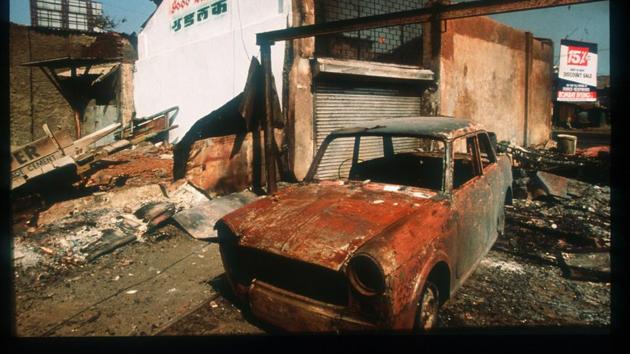From Ayodhya to Mumbai and back | Opinion
In 2020, go back to the riots and violence of 1992-93. There has been no closure, no justice
In television newsrooms, the Ram mandir bhoomi pujan on August 5 was a grand spectacle where a religious epic met a modern-day political supremo. As multiple cameras tracked every move of Prime Minister (PM) Narendra Modi with breathless excitement, I must confess to switching off from the frenzy. My mind instead was rewinding to another big news day. For long before August 5, 2020, there was December 6, 1992.

It was a Sunday and I was playing a cricket match in the genteel environs of the Bombay Gymkhana when the news trickled in around noon that the Babri masjid had been demolished in Ayodhya. Abandoning the game mid-way, I rushed to work. This was a pre-24x7 breaking news television era and our somnolent newspaper office in Mumbai seemed another universe away from the happenings in the temple town.
It was only late evening as the images of the demolition were telecast on BBC that there was a marked shift in mood. That night, we got the first reports of stone-throwing near Minara masjid in the congested by-lanes of Bhendi Bazaar. A police wireless van had been attacked by a mob: The men in khakhi were seen as a symbol of government authority which had failed to protect the mosque. By midnight, there was visible tension in the air. Policemen were patrolling the streets even as the stone-throwing continued in some parts. The next day, the local Muslim League called a bandh, and a curfew was declared in central Mumbai even as the violence spread to the suburbs. For the next three months, Mumbai would be shaken out of its cosmopolitan illusions. A riot that began in December between the police and angry Muslim groups would transform in January into aggressive street mobilisation by militant Hindu outfits and culminate in March 1993 in serial blasts triggered by the Dawood Ibrahim-led underworld.
For an archetypal south Mumbai child of relative privilege, the riots and terror attack were a wake-up call. Under the city of gold lurked an underbelly of grime, an overcrowded metropolis that was sitting on a combustible tinderbox. The Babri demolition had exposed Mumbai’s fault-lines and left the city at the mercy of resentful Muslim groups, Shiv Sena storm troopers, underworld gangs and a partisan police force. Outside my south Mumbai comfort zone, I was exposed to another Mumbai. We met dozens of families who were caught in the crossfire, forced to abandon their homes and flee, others whose shops and offices had been burnt down. More than 1,000 people died in Mumbai’s twin riots and blasts, a majority of them faceless, innocent citizens targeted for their religious identity.
In late 1993, as an eyewitness to the carnage, I deposed before the Justice Srikrishna Commission that was appointed to inquire into the Mumbai violence. The cross-examination went on for three days. A tough Shiv Sena lawyer and Member of Parliament (MP), Adhik Shirodkar, was unbending in his interrogation. At the Mumbai reporting team of The Times of India, we even compiled a book, When Bombay Burned, detailing the chain of bloody events that had traumatised the city. Publishing was still in infancy and only around 1,000 copies of the book were printed. It was easily the most harrowing, gut-wrenching year in my professional life — a city that I loved dearly had been scarred, perhaps forever. Mumbai was sharply divided on communal lines. A Hindu-Muslim physical and psychological fracture occurred in those months that has never quite healed.
Twenty-eight years later, the wheel has come full circle. Here we are in a new, distinctly polarised India, where majoritarian politics is now mainstream, where the lines between secular and communal, law and illegality have been conveniently erased. The Shiv Sena, whose leader Bal Thackeray claimed in 1992 to be “proud of his boys” for their role in the demolition, is now the party in power in Maharashtra with the Congress as a junior ally. The Bharatiya Janata Party (BJP), for which the Ayodhya movement was the passport to political influence, is now the country’s dominant political formation. Narendra Modi who earned his spurs while organising the 1990 Ram Janmabhoomi rath yatra that gained momentum and eventually led to the masjid’s demolition is now the country’s all-powerful leader. The Indian Muslim is a fearful, marginal voice, ghettoised and demonised as the permanent other.
The law has failed to take its course. A majority of the 2,000 odd cases that were registered in connection with the Mumbai riots have been closed. There have been a handful of convictions, but most of the accused are out on bail. The Srikrishna report, which indicted the Sena and Mumbai police officers, was never acted upon and eventually dumped by the Maharashtra government. The Babri masjid demolition trial is still going on in a special court in Lucknow with no convictions. The high-profile politicians named in an FIR are now part of the power elite. No one who suffered in the post-Babri violence can claim to have got any justice or closure from a compromised State machinery.
As for me, I remain haunted by the images of rioting and destruction, of the smoke-filled skies of a city’s social fabric being torn apart, of tearful Mumbaikars with their agonising stories of despair. The PM may have likened August 5 to the freedom movement but the festivities of the mandir nirman will always remind me of December 6, the day when vandalism triumphed over the Constitution and violence over ahimsa.
Postscript: My children are the post-Babri generation, born years after the demolition and, like millions of millennials, with no link to the past. Maybe, one day, they will read our Mumbai riots book, if only to realise that the foundation of a shiny new India has been built on the debris of a bloodied old order.






